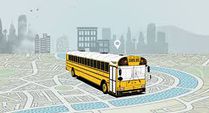Group25 Proposal
Recommendation for Singapore Bus Routes Enhancement
A web-based analytics application to visualize how bus routes can be made more efficient
|
|
|
|
|
|
Abstract
Buses forms a significant part of public transport in Singapore, Singapore's bus system has an extensive network of routes covering most places in Singapore, with over 3.9 million rides taken per day on average as of 2016, and is the most economical way to get around, as well as being one of the most scenic. There are more than 300 scheduled bus services, operated by SBS Transit, SMRT Buses, Tower Transit Singapore and Go-Ahead Singapore. The newest bus operator, Go-Ahead Singapore started operation from 4 September 2016. There are also around 4,600 buses currently in operation.
It plays a cardinal role in escalating the mobility, prosperity and connectivity of a community. The more the people are satisfied with the public transportation, the more they tend to use it. The more the people use public transportation, the higher are the chances of them not buying a personal vehicle. The higher the chances of people not buying a personal vehicle, the lesser we will see cars running on the road. The lesser the cars running on the road the lesser will be the pollution generated. So, If we look at the macro picture, we see that not only the society gets affected with public transportation system but also the whole world. And, everything then comes down to the satisfaction level of the people using it.
Our objective in taking up this project is to improve the efficiency and optimize the current Singapore bus route, and most importantly to increase the passenger satisfaction. If we are successfully able to determine the ways to split the buses that have very long travelling time, not only we will be able to reduce travelling time,but we will also able to reduce overcrowding problem that currently Singapore buses have.
Also, if we successfully map the current bus route that pass through multiple stops in that area, we will be able to show LTA that there are still more rooms for improvement to increase customer satisfaction.
Issues and Problem
Some of the buses have too long traveling time in one routes. Usually this type of bus has 2 routes, circling around the area, then transit into highway into another area. This type of bus route can cause overcrowding in a bus, and passenger alighting at the end of the circle before the transit will be stuck with overcrowding. (need to be further explained)
Other problem that Singapore bus currently have is there are buses that do not stop in bus stops even though they are inside the bus coverage routes. This can create problem for elderly passenger (or passenger in special needs) as the passenger needs to walk to the other bus stops even though there are bus stops near the passenger place that the bus pass through. (need to be further explained)
Challenges
Some of the challenges that we will encountered in this project:
- Finding appropriate longest route with longer time.
This is not only a road block but the first stepping stone. As the we aim to optimize the bus routes we need to spot the longest routes with the longer time. Once we are done with this we can investigate further on how close the bus stops are on the way and how can we decrease the the time taken by the bus to cover its whole journey. - Finding nearest bus stops to MRT station.
Since MRT stations are the most important source as well as destination for the Bus commuters, So the distance to/from a Bus Stop is always of utmost importance. So, for these hotspots we have to find the nearest bus stop and optimize them, if possible. For example, If a bus service is already passing by the MRT and still it’s bus stop is quite far ( say more than 50m ) Then we can optimize it to the nearer one, if any. Also, if there’s a case that there is not even a single bus stop near an MRT station then we can propose to build one.
Data Source
Our data is collected by using LTA's API to access their database and scrape the data by using Python. The dataset that we currently have are:
- Singapore Bus Stops.
This dataset contain list of all currently existed Bus Stops across whole Singapore. It contained 4,985 data consist of unique code as well as the latitude and longitude coordinate for each Bus Stop. However, as the coordinate is based on WGS84(World Geodetic System), we have to convert the coordinate into SYV21 system. Detailed step to convert will be explained in the report.
Below is the sample of this dataset. - Singapore Bus Routes.
This dataset contain list of all route that Singapore bus currently have. It contained 25,959 data consist of bus stops code and the bus service number, as well as the distance between each bus stops that buses follow.
Below is the sample of this dataset. - Singapore Bus Services.
This dataset contain list of all Singapore Bus that currently in service. It contained 1,410 data consist of buses code, and the destination code for that bus.
Below is the sample of this dataset. - MRT Stations coordinate.
This dataset contain coordinate of all Singapore MRT Stations. Unfortunately, the file is in SHP and we can only open one of the .SHP file using JMP. Therefore, there are no detail regarding the name of the MRT stations. We will have to manually match the data with the MRT Station in google map based on this coordinate. The coordinate is based on SVY21 system.
Below is the sample of this dataset.
The metadata for our datasets is provided from LTA's website.
Link for the metadata: https://www.mytransport.sg/content/dam/datamall/datasets/LTA_DataMall_API_User_Guide.pdf
